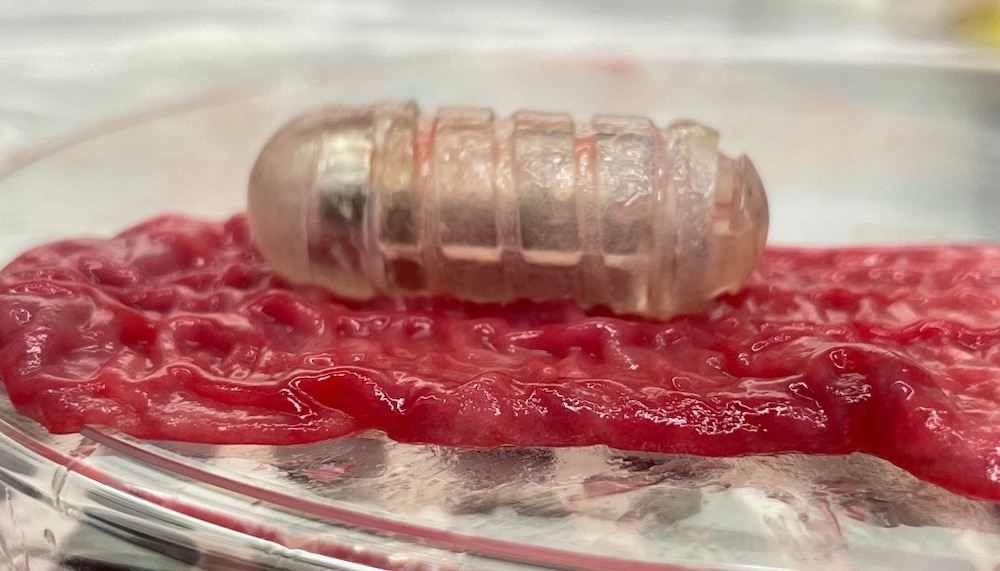Create a free profile to get unlimited access to exclusive videos, sweepstakes, and more!
This edible robot scrubs through intestinal mucus to deliver drugs
Did you remember to eat your robot today?

The Andromeda Strain was the novel that put Michael Crichton on the map. Published in 1969, beneath the shadow of the Apollo program, it hit shelves at the peak of humanity’s anxieties and interest about space exploration. In the book, and the subsequent film adaptation, a downed satellite introduces a deadly pathogen to the town of Piedmont, Arizona. The titular Andromeda strain kills swiftly by way of catastrophic blood clotting when the pathogen enters the body. What is initially identified as an alien microbe is later revealed, in the 2019 sequel The Andromeda Evolution, to be an artificial creation present on every celestial body we’ve ever encountered. Once it contacts the mouth or nose it invades the body and kills all but a lucky few. It's the sort of story which emerges from within the human psyche at the edges of new horizons, a product of our fears about what may be waiting for us as we transition out of our species’ adolescence.
Luckily, there were no destructive alien microbes, artificial or otherwise, waiting for us as we took our first steps beyond our home planet. Although, that wasn’t a given. The Apollo astronauts spent a few weeks in quarantine upon returning home just in case. Ultimately, however, if we wanted ingestible machines capable of influencing our bodies for good or ill, we’d have to make them ourselves.
Amro Alshareef from the Department of Mechanical Engineering at MIT, and colleagues, have developed a consumable pill about the size of a common multivitamin which could be considered the real-world spiritual sibling to Crichton’s Andromeda strain, only this device is intended to heal instead of harm. The device in question, dubbed RoboCap, was revealed in a recent issue of Science Robotics and could provide a new and better way to deliver therapeutic drugs.
“For orally administered drugs, they have to get through the mucus barrier that lines the soft tissues. For a lot of drugs like insulin, after they get through the acid in the stomach and the mucus barrier, they don’t actually get to the lining where they can be absorbed,” Alshareef told SYFY WIRE.
That’s a problem. Getting drugs into the body is one thing, but the whole endeavor falls apart if they’re gummed up by mucus and never actually enter the bloodstream. RoboCap cuts through the mucus barrier, quite literally, by acting as a tunneling device. Through a combination of external design and internal mechanics, the pill navigates through mucus to interface directly with the soft tissue. Perhaps fittingly, it works similarly to the ways in which some satellites and space probes orient themselves in space.
“There is a motor that spins an offset weight at a really high frequency and that causes a sort of offset in the balance of the pill, leading to a teeter totter effect. The system wants to counteract that through conservation of momentum so the whole pill spins in the opposite direction as the weight,” Alshareef said.
As the pill spins, grooves on it surface tunnel through mucus, shoveling it away. Then, because the pill is denser than the fluids in the digestive system, it sinks into the mucus until it settles onto the surface of the stomach or intestinal lining. Once it reaches its destination, the pill releases its pharmaceutical payload over the course of roughly 10 or 20 minutes.
“On one end there is a membrane that encapsulates the drug compartment. As it rotates and goes into the mucus barrier, that compartment slowly dissolves. Once that’s done, the remainder of the capsule is completely enclosed in a biocompatible enclosure and it passes just like anything else you would swallow, over the course of a few days,” Alshareef said.
Getting the robotic pill to work presented some unique engineering challenges including getting it down to size. If you’re going to swallow something, you want to make sure it can safely get through the throat and out the other side. Researchers started with a capsule about twice the size of the current iteration and worked to get the pill down to size.
“It couldn’t be larger than a triple zero size pill, which is the same as a common multivitamin. That’s the largest FDA approved size for an orally consumed pill. On the other end, with all the electronics inside, it was quite difficult to get it to the small size,” Alshareef said.
At present, RoboCap has been tested with both insulin and the antibiotic vancomycin. Although researchers believe it will work with a wide range of medications. “We would have to test other drugs, but this is a mechanical effect. It’s not like other chemical additions which allow penetration through the mucus barrier and other barriers. We don’t anticipate any drug being inhibited by this mechanical motion.” Alshareef said.
In the case of insulin, the results were promising. Testing the device in pigs, researchers saw a 20% to 40% increase in drug delivery, as compared to conventional oral medications. According to Alshareef, orally administered insulin has a typical bioavailability of only about 1% so the RoboCap represents a significant increase in our ability to deliver insulin into the bloodstream without an injection.
Despite its promising results, a robotic pill capsule won’t be a part of a balanced breakfast anytime soon. The device needs additional testing, including clinical trials in humans and FDA approvals before it hits pharmacy shelves or hospitals.


























